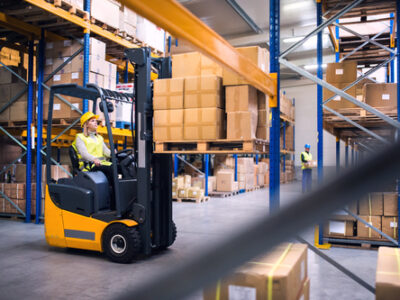 Operating a forklift is a responsible task that requires proper training and adherence to safety guidelines. Whether you’re a new forklift operator or a seasoned professional, it’s crucial to prioritize safety at all times. In this blog post, we will discuss essential tips and practices for safely operating a forklift, ensuring the well-being of yourself and those around you.
Operating a forklift is a responsible task that requires proper training and adherence to safety guidelines. Whether you’re a new forklift operator or a seasoned professional, it’s crucial to prioritize safety at all times. In this blog post, we will discuss essential tips and practices for safely operating a forklift, ensuring the well-being of yourself and those around you.
1. Obtain Proper Training and Certification
Before operating a forklift, it’s essential to receive proper training from a certified instructor. Forklifts present unique challenges and require specific skills and knowledge to operate safely. Training programs cover topics such as load capacity, stability, maneuvering, and safety procedures. Additionally, obtaining certification ensures that you not only understand how to operate the forklift but also comply with legal requirements.
2. Pre-Operational Checks
Performing pre-operational safety checks is a crucial step to ensure the forklift is in good working condition. Before each shift, inspect the forklift for any visible damages, leaks, or loose parts. Check the tires, brakes, steering, horn, lights, forks, and hydraulic controls. Ensure the seat belt is functional and the fire extinguisher and other safety devices are present and properly maintained. Any issues or concerns should be reported to a supervisor or maintenance personnel before using the forklift.
3. Wear Personal Protective Equipment (PPE)
Personal Protective Equipment (PPE) plays a vital role in forklift safety. Always wear the appropriate PPE, which includes a hard hat, safety glasses, steel-toed boots, and high-visibility clothing. These items protect you from potential hazards such as falling objects, flying debris, and accidental collisions. Additionally, PPE helps make you easily visible to others while operating the forklift, reducing the risk of accidents.
4. Know and Follow Load Capacity
Understanding the forklift’s load capacity is essential for safe operation. Every forklift has a maximum load capacity designated by the manufacturer. Never exceed this capacity as it can compromise the stability of the forklift and create a hazardous situation. Familiarize yourself with load mass, size, and shape, and ensure you know how to properly secure and balance the load. Improperly stacked or unbalanced loads can lead to accidents, such as tip-overs or falling objects.
5. Maintain Safe Speed and Distance
Maintaining a safe speed and distance is critical for preventing accidents, especially in busy work environments. Always follow speed limits and adjust your driving speed according to the road conditions. Slow down when turning, crossing intersections, or operating on inclines. Additionally, maintain a safe distance from pedestrians, other forklifts, and obstacles to avoid collision risks. Be attentive and use mirrors and horns to alert others of your presence.
6. Practice Proper Forklift Maneuvering
Proper maneuvering techniques are essential for avoiding accidents and ensuring stability. When turning, use a wide turning radius to prevent tipping or imbalance. Slow down and approach corners with caution. When traveling on sloping surfaces, always keep the load uphill to ensure better stability. Be cautious of overhead hazards such as low-hanging objects or door frames, and exercise extra care in these situations.
7. Communicate Effectively
Effective communication is crucial for a safe work environment when operating a forklift. Use hand signals or audible warnings when approaching pedestrians or other forklift operators. Be aware of blind spots and use mirrors to enhance your visibility. If another forklift approaches, establish eye contact with the driver to ensure mutual awareness. Always follow designated traffic lanes and avoid unnecessary distractions such as using a cellphone while operating the forklift.
Conclusion
Safely operating a forklift should always be a top priority. By obtaining proper training and certification, performing pre-operational checks, wearing appropriate personal protective equipment, understanding load capacity, maintaining a safe speed and distance, practicing proper maneuvering techniques, and communicating effectively, you can greatly reduce the risk of accidents. Remember, the safety of yourself and those around you depends on your dedication to following these essential guidelines.
